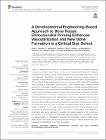| dc.contributor.author | Kelly, Daniel | |
| dc.date.accessioned | 2021-01-25T17:48:00Z | |
| dc.date.available | 2021-01-25T17:48:00Z | |
| dc.date.issued | 2020 | |
| dc.date.submitted | 2020 | en |
| dc.identifier.citation | Freeman, F.E., Brennan, M.Á.,,Browe, D.C., Renaud, A., De Lima J.,Kelly, D.J., McNamara, L.M., Layrolle, P., A Developmental Engineering-Based Approach to Bone Repair: Endochondral Priming Enhances Vascularization and New Bone Formation in a Critical Size Defect, Frontiers in Bioengineering and Biotechnology, 2020, 8:230 | en |
| dc.identifier.other | Y | |
| dc.identifier.uri | http://hdl.handle.net/2262/94799 | |
| dc.description.abstract | There is a distinct clinical need for new therapies that provide an effective treatment for large bone defect repair. Herein we describe a developmental approach, whereby constructs are primed to mimic certain aspects of bone formation that occur during embryogenesis. Specifically, we directly compared the bone healing potential of unprimed, intramembranous, and endochondral primed MSC-laden polycaprolactone (PCL) scaffolds. To generate intramembranous constructs, MSC-seeded PCL scaffolds were exposed to osteogenic growth factors, while endochondral constructs were exposed to chondrogenic growth factors to generate a cartilage template. Eight weeks after implantation into a cranial critical sized defect in mice, there were significantly more vessels present throughout defects treated with endochondral constructs compared to intramembranous constructs. Furthermore, 33 and 50% of the animals treated with the intramembranous and endochondral constructs respectively, had full bone union along the sagittal suture line, with significantly higher levels of bone healing than the unprimed group. Having demonstrated the potential of endochondral priming but recognizing that only 50% of animals completely healed after 8 weeks, we next sought to examine if we could further accelerate the bone healing capacity of the constructs by pre-vascularizing them in vitro prior to implantation. The addition of endothelial cells alone significantly reduced the healing capacity of the constructs. The addition of a co-culture of endothelial cells and MSCs had no benefit to either the vascularization or mineralization potential of the scaffolds. Together, these results demonstrate that endochondral priming alone is enough to induce vascularization and subsequent mineralization in a critical-size defect. | en |
| dc.language.iso | en | en |
| dc.relation.ispartofseries | Frontiers in Bioengineering and Biotechnology; | |
| dc.relation.ispartofseries | 8; | |
| dc.relation.ispartofseries | 230; | |
| dc.rights | Y | en |
| dc.subject | Endochondral ossification | en |
| dc.subject | Intramembranous ossification | en |
| dc.subject | Bone tissue engineering | en |
| dc.subject | Pre-vascularization | en |
| dc.subject | Mesenchymal stem cells | en |
| dc.title | A Developmental Engineering-Based Approach to Bone Repair: Endochondral Priming Enhances Vascularization and New Bone Formation in a Critical Size Defect | en |
| dc.type | Journal Article | en |
| dc.contributor.sponsor | Science Foundation Ireland | en |
| dc.type.supercollection | scholarly_publications | en |
| dc.type.supercollection | refereed_publications | en |
| dc.identifier.peoplefinderurl | http://people.tcd.ie/kellyd9 | |
| dc.identifier.rssinternalid | 223060 | |
| dc.identifier.doi | http://dx.doi.org/10.3389/fbioe.2020.00230 | |
| dc.rights.ecaccessrights | openAccess | |
| dc.contributor.sponsorGrantNumber | Science Foundation Ireland (SFI) Investigators Programme Grant 258992 | en |
| dc.identifier.orcid_id | 0000-0003-4091-0992 | |




